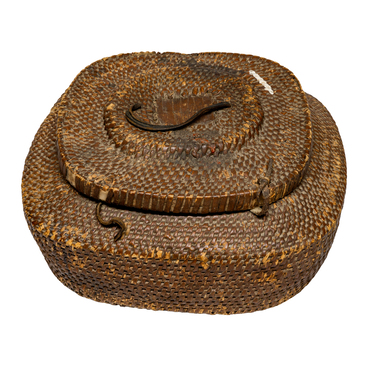A tea tin box from the collection of Nizhnevartovsk Museum of Local History was made in Moscow in the 1920s or 1930s. It is rectangular with rounded corners. A lid is attached to a tin container with a special hinge. There are some fruits depicted against light-colored background on the sides of the box: peaches, pears, grapes. A similar, but larger picture is on the top of the lid.
This tea box was made for the Moscow Tea Packing Factory named after V. I. Lenin, which produced goods with the emblem “Tea Department. Moscow”. Its main store was located on Myasnitskaya str., in the former estate of the Izmailov family. Before the Russian revolution, the tea merchant Sergey Perlov’s shop was located there. In 1895, its entrance was decorated in the Chinese style. There was a decorative panel depicting a peacock over a door, the facade was decorated with ceramic tiles with relief drawings of mythical animals. Its turret was made in the form of an Asian pagoda. Sergey Perlov ordered the interior details, such as silk wall panels, vases, luminaires from Chinese craftsmen.
After the Russian revolution, Perlov’s store became state property and a part of the Moscow Tea factory. At the beginning of the 20th century, this company was the biggest tea factory in Russia. Special leaflets were printed to advertise it. They used to be put into the boxes with tea, coffee, and cocoa. In 1924, Vladimir Mayakovsky wrote the texts for advertising purposes:
This tea box was made for the Moscow Tea Packing Factory named after V. I. Lenin, which produced goods with the emblem “Tea Department. Moscow”. Its main store was located on Myasnitskaya str., in the former estate of the Izmailov family. Before the Russian revolution, the tea merchant Sergey Perlov’s shop was located there. In 1895, its entrance was decorated in the Chinese style. There was a decorative panel depicting a peacock over a door, the facade was decorated with ceramic tiles with relief drawings of mythical animals. Its turret was made in the form of an Asian pagoda. Sergey Perlov ordered the interior details, such as silk wall panels, vases, luminaires from Chinese craftsmen.
After the Russian revolution, Perlov’s store became state property and a part of the Moscow Tea factory. At the beginning of the 20th century, this company was the biggest tea factory in Russia. Special leaflets were printed to advertise it. They used to be put into the boxes with tea, coffee, and cocoa. In 1924, Vladimir Mayakovsky wrote the texts for advertising purposes:



